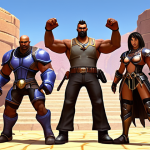Reverse: 1999 truly captivated me from the moment I first saw its unique aesthetic and heard those intriguing character voices. It felt like stepping into a carefully crafted time capsule, and for a while, the community buzzed with nothing but excitement and theories.
But then, as often happens in the volatile world of live-service games, the whispers started, growing louder until they erupted into what many of us experienced as significant community drama.
I remember feeling that collective tension myself, the air thick with passionate debates and, at times, palpable frustration over recent developments.
It wasn’t just a fleeting moment; it really underscored how deeply invested players become and how quickly trust can be shaken when expectations clash with reality.
This incident, in my opinion, highlights a critical, ongoing trend in the gaming industry: the delicate balance developers must strike between evolving content and maintaining player satisfaction, especially as we head into an era where player-developer transparency is paramount.
Let’s uncover the full story.
The Brewing Storm: Unpacking Early Disquiet

I remember when the initial buzz around Reverse: 1999 was almost palpable. Everyone, myself included, was completely charmed by its unique art style and that intriguing time-traveling premise. It felt fresh, distinct, and promised a narrative depth that many gacha games often gloss over. For a good while, the community, brimming with anticipation, was a fantastic place to be, sharing theories and gushing over character designs. Yet, beneath that surface of excitement, tiny fissures began to appear. It wasn’t an explosive start to the drama, but more of a slow, creeping unease that, looking back, felt almost inevitable once you noticed the patterns. It really underscored how, even with the best intentions, the smallest missteps can chip away at the foundation of trust between players and developers, especially when core expectations about a game’s direction or monetization start to feel misaligned. This gradual build-up is something I’ve seen play out in other live-service titles, but with Reverse: 1999, it felt particularly poignant given the sheer passion players had for its distinct world.
1. The Weight of Unfulfilled Promises: When Expectations Clash with Reality
One of the earliest pain points, for me and many others, stemmed from a growing perception that certain promises, whether explicit or implied, weren’t quite materializing as expected. I recall the excitement surrounding character releases, only for some players to feel that the actual utility or integration of these characters didn’t quite live up to the hype built during their reveal. It wasn’t about power creep so much as a disconnect between how a character was presented and how they truly fit into the game’s evolving meta. There were also concerns about the pacing of new content, with some feeling that updates, while arriving, didn’t always provide the substantial, narrative-driven experiences that players had initially fallen in love with. It’s like being promised a gourmet meal and getting a perfectly edible, but somewhat bland, dish instead. That feeling of anticipation turning into mild disappointment, accumulating over time, truly set the stage for later, more significant disquiet. It’s a subtle but powerful erosion of good faith that’s hard to recover from.
2. Navigating the Whispers: Community Sentiment Before the Outburst
Before the full-blown drama erupted, the community was a fascinating landscape of cautious optimism mixed with growing murmurs of discontent. On platforms like Reddit, Discord, and Twitter, you could see the shift. Initially, it was all fan art and excited theorycrafting. Then, threads started appearing, gently questioning certain design choices, the perceived generosity of in-game rewards, or the frequency of bug fixes. I remember reading discussions where players were trying to figure out if what they were experiencing was an isolated issue or a widespread sentiment. It was a period of collective feeling-out, where people were weighing their personal enjoyment against these nascent concerns. These whispers weren’t loud complaints yet, but rather genuine attempts to understand if their growing unease was shared. It felt like walking on eggshells, where everyone loved the game deeply but was starting to realize that something wasn’t quite right, and the potential for a larger issue loomed just beneath the surface.
From Murmurs to a Movement: The Escalation of Player Advocacy
The transition from those quiet whispers of concern to a full-fledged community outcry was something truly remarkable to witness. It wasn’t a singular event that triggered it all, but rather a perfect storm of cumulative frustrations reaching a breaking point. I remember one specific patch update that seemed to amplify everything. It introduced changes that many felt were antithetical to the game’s original appeal or simply demonstrated a lack of understanding regarding player priorities. Suddenly, the isolated complaints converged, finding common ground in shared grievances. It felt like a dam breaking, where players who had been silently stewing finally found their voice, realizing they weren’t alone in their disappointment. The collective energy was palpable, transforming individual grievances into a unified demand for change. As a player deeply invested in the game’s unique world, I genuinely felt that sense of urgency and shared frustration, recognizing that for many, this wasn’t just about a game anymore; it was about the fundamental relationship between a developer and its dedicated player base.
1. The Catalyst Moment: What Sparked the Collective Outcry
While various factors contributed to the rising tension, there often comes a single, defining moment that serves as the catalyst for widespread community drama, and for Reverse: 1999, I believe it was a combination of perceived missteps in a particular patch and a general feeling of disregard for player feedback. For many, it felt like the developers were either not listening or simply didn’t grasp the core issues that were bothering the player base. This could have manifested in anything from changes to character balance that felt unwarranted, to events that offered underwhelming rewards, or even the introduction of new monetization schemes that felt predatory. What truly pushed it over the edge was the feeling that these changes were not just minor annoyances, but fundamental shifts that threatened the long-term enjoyment and fairness of the game. I personally felt that distinct sting of betrayal when I saw the community react so strongly; it mirrored my own growing disillusionment and validated the quiet fears I’d been harboring about the game’s direction.
2. The Power of Social Platforms: Amplifying Voices and Demands
Social media and community platforms like Reddit, Discord, and Twitter played an absolutely pivotal role in amplifying the collective outrage. It was incredible to see how quickly information, frustrations, and calls to action spread. Threads detailing grievances went viral within hours, discussion channels became hubs for organizing and strategizing, and hashtags began trending as players sought to draw attention to their concerns. The sheer speed at which a unified voice emerged was a testament to the power of these digital spaces. I recall spending hours refreshing feeds, watching as thousands of players shared their experiences, screenshots, and well-articulated critiques. This rapid dissemination of information not only solidified the community’s stance but also made it impossible for the developers to ignore the growing unrest. It transformed scattered complaints into a formidable, organized movement, demonstrating that players, when united, possess a significant influence over the trajectory of a live-service game.
The Developer’s Dilemma: Navigating the Backlash and Responding
Watching a game developer navigate a significant community backlash is always a fascinating, if often painful, process. It’s a tightrope walk where every statement, every patch note, and every public appearance is scrutinized with a magnifying glass. For Reverse: 1999, the initial developer responses felt, to many of us, like they were missing the mark, or perhaps, weren’t delivered with the urgency and empathy that the escalating situation demanded. There’s a fine line between acknowledging player feedback and truly demonstrating that you understand the depth of their frustration. At times, it felt like a game of telephone, where the message coming from the development team wasn’t quite landing with the passionate players who felt so deeply invested in the game’s success. It was clear that the stakes were incredibly high; not just for the game’s immediate future, but for the long-term trust that forms the bedrock of any successful live-service title. The way they chose to address, or not address, certain issues would inevitably define how the community perceived their commitment.
1. Initial Responses and Their Repercussions: Acknowledging or Dismissing?
When the community drama first peaked, the initial responses from the Reverse: 1999 development team were, to put it mildly, met with mixed reactions. Some players felt their concerns were dismissed, or that the communication was too vague, failing to address the specific pain points that had ignited the firestorm. It often felt like general statements were being made instead of concrete action plans. I remember feeling a surge of disappointment when I saw a carefully worded official statement that, while acknowledging “feedback,” didn’t quite capture the raw emotion and specific grievances pouring out from the community. It’s like telling someone who’s really upset, “I hear you,” without validating their feelings or offering a clear path forward. This initial perceived lack of directness or empathy only served to further inflame passions, making players feel even more unheard and undervalued. It’s a common pitfall in crisis communication, and sadly, it played out here.
2. The Evolving Strategy: From Silence to Engagement (and Back Again?)
Over time, the developer’s communication strategy seemed to evolve, albeit with some bumps along the road. There were periods of relative silence, which often led to increased speculation and frustration within the player base. Then, there would be attempts at engagement, sometimes through Q&A sessions or more detailed developer notes. However, the consistency of this engagement, and the substance of the responses, were often questioned. It was a constant push and pull. I observed moments where it felt like they were genuinely trying to connect, only for another update or announcement to inadvertently re-ignite old frustrations. This inconsistent approach meant that while some issues were eventually addressed, the overall feeling of being truly listened to remained elusive for many. It underscored how critical consistent, transparent, and empathetic communication is, especially when trust has been eroded.
Rebuilding Bridges: Paths to Reconciliation and Recovery
After the dust settled from the initial explosion of community drama, the focus naturally shifted towards what comes next. How do you, as a developer, pick up the pieces and start rebuilding that fractured trust? It’s not just about fixing bugs or tweaking numbers anymore; it’s about mending a relationship that’s been strained, sometimes severely. For Reverse: 1999, the journey to reconciliation has been a winding one, marked by both sincere efforts and continued challenges. I’ve personally watched the community, once fiercely unified in its complaints, begin to splinter slightly, with some players cautiously returning, others remaining skeptical, and a few deciding to walk away entirely. This phase is perhaps the most critical because it tests the developer’s long-term commitment to listening and adapting. It’s not a quick fix, but a marathon of consistent, positive action and transparent communication that ultimately determines if a game can truly recover its player base’s faith.
1. Community-Led Initiatives: Players Stepping Up to Fill the Void
Interestingly, during and after the peak of the drama, I saw a remarkable phenomenon: the community itself began to create solutions and foster positive spaces. Players who genuinely loved the game, despite their frustrations, started Discord servers dedicated to constructive feedback, organized fan events, and even created their own comprehensive guides and content to help new players or those struggling with the game’s changes. It felt like an organic effort to “save” the game they cherished. This wasn’t about protesting anymore; it was about preserving the good parts and pushing for betterment from within. I found myself drawn to these initiatives, contributing where I could, because it felt like a proactive way to channel the collective passion into something productive. It was a clear sign that the desire for Reverse: 1999 to succeed was still incredibly strong, even amidst the turmoil.
2. Tangible Changes and Their Reception: Are Developers Listening Now?
Eventually, the development team did implement several changes that were direct responses to player feedback. This included adjustments to character balance, revisions to certain event mechanics, and even improvements to the overall in-game economy. The reception to these changes was, predictably, varied. For some, it was a welcome step in the right direction, a sign that their voices had finally been heard. For others, it felt like too little, too late, or that the changes didn’t fully address the root causes of their dissatisfaction. I personally felt a sense of cautious optimism. It wasn’t a perfect recovery, but it showed that the feedback loop was, at least to some extent, starting to function. It highlighted the complexity of satisfying a diverse player base, where every fix for one group might not fully resonate with another. The critical question became whether these changes were isolated fixes or part of a broader, sustained commitment to player-centric development.
The Broader Canvas: Lessons for the Live-Service Gaming Landscape
The saga of Reverse: 1999’s community drama isn’t just an isolated incident; it’s a stark case study packed with crucial lessons for the entire live-service gaming industry. As someone who’s poured countless hours into various online titles, I’ve observed this pattern play out in different forms, but the intensity and specifics here truly underscore some fundamental truths about what makes these games thrive or falter. It’s not just about flashy graphics or deep lore; it’s about the delicate, evolving relationship between the creators and their dedicated player base. This incident, from my perspective, should serve as a wake-up call for developers and publishers alike, highlighting the paramount importance of transparent communication, genuine player engagement, and a sustainable monetization model that respects the player’s time and investment. We’re moving into an era where players expect to be partners in the journey, not just consumers, and the games that fail to recognize this shift will undoubtedly struggle in the long run.
1. The Paramount Importance of Communication: A Two-Way Street
If there’s one overarching lesson to take from this, it’s that consistent, clear, and empathetic communication is absolutely non-negotiable for live-service games. It’s not enough to release patch notes; developers need to engage in a genuine dialogue, explaining *why* decisions are made, addressing concerns directly, and providing a realistic roadmap. I’ve often felt that silence or vague statements in times of crisis only breed suspicion and amplify frustration. Players want to feel heard, and they want to understand the rationale behind changes that impact their game experience. This isn’t just about putting out fires; it’s about building a robust communication framework that fosters trust even before issues arise. My experience tells me that even if players don’t always agree with a decision, they’re far more likely to accept it if they feel it was communicated openly and honestly.
2. Balancing Monetization with Player Experience: A Delicate Tightrope Walk
Another critical takeaway revolves around the constant tension between a game’s monetization strategy and the overall player experience. In the world of live-service games, revenue is essential for continued development, but aggressive or perceived “greedy” monetization practices can quickly alienate a dedicated player base. I’ve seen countless games stumble because they prioritized short-term gains over long-term player satisfaction. The Reverse: 1999 situation, at its core, touched upon these sensitivities. It’s about finding that sweet spot where players feel their investment (whether time or money) is valued, and that the game isn’t designed to constantly push them towards purchases. A truly sustainable model enhances, rather than detracts from, the enjoyment of the game, making monetization feel like a fair value exchange, not a coercive tactic. This is an area where many developers are still struggling to find the right balance.
The Player’s Heartbeat: Why We Care So Much About Our Digital Worlds
It might seem dramatic to outsiders, this level of intense emotional investment in a video game, but for those of us who dive deep into these digital worlds, it’s anything but. Reverse: 1999, with its captivating narrative and unique characters, truly became more than just a pastime for many players. It was a space for escape, for connection, and for shared passion. When something you care about so deeply faces turbulence, whether it’s perceived missteps from developers or major community conflicts, the impact isn’t just intellectual; it’s profoundly emotional. I’ve personally experienced that gut-wrenching disappointment when a game I cherish feels like it’s veering off course, or when the community that once felt like a haven becomes a battlefield of arguments. It’s a reminder that live-service games aren’t static products; they are living, breathing entities sustained by the energy and loyalty of their players. The drama surrounding Reverse: 1999 truly laid bare just how much of our own passion we pour into these virtual experiences.
1. More Than Just a Game: The Emotional Investment in Virtual Universes
For many of us, games like Reverse: 1999 transcend mere entertainment. They become digital canvases where we build friendships, share unique experiences, and find solace in intricate lore and compelling characters. The emotional investment can be staggering. We spend hours, sometimes days, theory-crafting, grinding for resources, pulling for that one coveted character, or simply immersing ourselves in the story. When a game’s development takes a turn that feels disrespectful to that investment, it’s not just a product failing; it feels like a personal slight. I felt that acutely when the drama unfolded. It wasn’t just about a game’s mechanics; it was about the potential loss of a world I’d come to love, and the erosion of a community I’d grown to value. This deep emotional connection explains why community reactions, when negative, can be so intense and why players fight so passionately for the games they adore.
2. The Community as a Sanctuary: Finding Belonging and Shared Passion
Beyond the game itself, the community surrounding a popular live-service title often becomes a sanctuary. It’s a place where shared interests forge real-world bonds, where you can geek out about character backstories, share strategies, and find solidarity in collective triumphs and frustrations. For Reverse: 1999, the community was initially a vibrant, supportive ecosystem. When the drama hit, it wasn’t just the game that suffered; the community itself became fractured. I saw friends disagree, discussion channels turn toxic, and the sense of unity begin to fray. It highlighted how integral a healthy community is to the overall player experience. When that sense of belonging is threatened, the impact reverberates beyond just the game’s immediate issues, making the recovery process even more challenging. It reinforced for me that the health of a game’s community is as important as the health of the game itself.
Peering into the Horizon: What the Future Holds for Reverse: 1999
After experiencing such a turbulent period, the natural question becomes: what does the future truly hold for Reverse: 1999? It’s a question I’ve pondered frequently, as have many in the community. The path forward is undoubtedly complex, requiring a delicate balance of addressing past grievances, delivering consistent quality content, and re-earning the trust that was so severely tested. It’s not just about one major update or a single apology; it’s about a sustained, long-term commitment to player satisfaction and transparent development. The game certainly has the foundational appeal to recover, given its unique aesthetic and compelling lore, but the road to full redemption will demand unwavering dedication. As a player who still holds a fondness for its distinct world, I’m watching closely, hoping that the lessons learned from this challenging period will forge a stronger, more player-centric future for Reverse: 1999 and set a positive example for other titles navigating similar waters.
1. Current Sentiment and the Path Forward: Cautious Optimism or Lingering Doubt?
The current sentiment within the Reverse: 1999 community is a fascinating mix of cautious optimism and lingering doubt. While some players have returned and are cautiously enjoying recent updates, others remain skeptical, waiting for more definitive proof of long-term commitment from the developers. There’s a tangible “wait and see” attitude. Many, including myself, are looking for consistency, not just sporadic improvements. It means not only delivering engaging content but also maintaining open lines of communication, even when discussions are difficult. The path forward demands sustained effort to not only fix technical issues but also to rebuild the emotional connection players felt with the game. It’s about proving that the game isn’t just a product, but a living world that the developers are truly invested in nurturing alongside their community.
2. The Role of Continuous Improvement: Evolving Beyond the Initial Storm
For Reverse: 1999 to truly thrive, continuous improvement must become its guiding principle, extending far beyond simply addressing the issues that sparked the initial drama. This means not just fixing bugs, but constantly innovating with new gameplay mechanics, expanding the lore in meaningful ways, and ensuring that the monetization model feels fair and balanced over time. It’s about building on strengths while learning from past mistakes. I’m personally looking for signs of a dynamic development process that can adapt to player feedback proactively, rather than reactively, especially as the game’s ecosystem evolves. This proactive approach, in my opinion, is what separates truly successful live-service games from those that merely survive; it signals a genuine commitment to providing an evolving, engaging experience for years to come.
| Aspect of Community Drama | Initial Community Experience | Impact During Peak Drama | Current Recovery Status (Developer Actions) |
|---|---|---|---|
| Monetization & Economy | Generally fair, some minor concerns about value. | Significant backlash over perceived predatory practices, reduced in-game currency/rewards. | Some adjustments to reward structures, increased free currency/pulls. Still an area of scrutiny. |
| Developer Communication | Adequate, but often formal and distant. | Perceived silence or vague, dismissive responses, leading to escalated frustration. | More frequent updates, some direct acknowledgments, but consistency varies. Improving slowly. |
| Game Content & Balance | Enjoyable, but with some minor character balance issues or content pacing concerns. | Major criticism regarding specific character nerfs/buffs, underwhelming event content, or lack of narrative depth. | Targeted balance adjustments, new events with improved rewards. Still evolving and being judged by players. |
| Player Trust & Sentiment | High initial trust, optimistic. | Severely eroded, widespread disappointment, feeling unheard/unvalued. | Gradual rebuilding, cautious optimism mixed with lingering skepticism. Long-term commitment needed to fully restore. |
A Blueprint for Success: How Other Games Can Learn from This Journey
The lessons gleaned from Reverse: 1999’s community turbulence are not just for its developers, but serve as a crucial blueprint for any aspiring or existing live-service game. As someone who invests heavily in these digital worlds, I’ve observed firsthand how crucial player-developer synergy is for long-term survival. This isn’t just about avoiding disaster; it’s about setting a foundation for sustained growth and genuine community engagement. The key takeaways emphasize proactive communication, an unwavering commitment to transparency, and a design philosophy that prioritizes player experience and satisfaction over short-term gains. It’s about recognizing that players are not just consumers; they are passionate stakeholders who contribute to the vibrancy and longevity of the game. For other games to truly succeed in this volatile landscape, they must internalize these lessons, ensuring that their development journey is a collaborative one, built on mutual respect and shared vision with their player base. It’s a challenging but ultimately rewarding path.
1. Prioritizing Proactive Engagement: Before Problems Arise
One of the most significant lessons is the absolute necessity of proactive engagement. Don’t wait for a crisis to start talking to your community. Establish transparent communication channels early, share development insights, and genuinely solicit feedback long before major changes are implemented. I’ve always found that developers who foster an open dialogue from day one tend to build a much stronger, more resilient community. When players feel involved in the process, they’re more understanding when challenges arise and more forgiving of missteps. This means regular Q&A sessions, developer diaries, and clear roadmaps that are regularly updated. It’s about making players feel like partners in the game’s evolution, rather than just recipients of updates. This pre-emptive trust-building is, in my experience, the most effective way to prevent minor issues from escalating into full-blown community dramas.
2. Cultivating Transparency: The Cornerstone of Trust
True transparency is incredibly hard to achieve but utterly vital. This isn’t just about announcing changes; it’s about explaining the “why” behind them, even when those explanations might be difficult. If a character needs a nerf, explain the data and the design philosophy behind it. If content is delayed, be honest about the challenges. I’ve seen countless instances where lack of transparency has bred distrust, speculation, and ultimately, anger. Players are smart, and they can often sniff out evasiveness. The Reverse: 1999 situation underscored that even small omissions can be amplified into significant issues when trust is low. A development team that consistently demonstrates honesty, even about its struggles, builds a bedrock of trust that can withstand the inevitable bumps in the road. This deep level of transparency, in my experience, makes all the difference in the long run.
Wrapping Up
As I reflect on the tumultuous journey of Reverse: 1999, it’s abundantly clear that the relationship between players and developers is a living, breathing entity. It requires constant nurturing, open dialogue, and a genuine willingness to adapt. My personal hope is that the profound lessons gleaned from this challenging period will pave the way for a stronger, more resilient future for the game. It truly underscores that even after the fiercest of storms, growth and renewed trust are not just possible, but essential, proving the enduring power of the passion we all pour into these incredible digital worlds.
Useful Information
1. When providing feedback, be specific and constructive, focusing on potential solutions rather than just airing grievances. This helps developers understand and address issues more effectively.
2. Always verify information through official game channels and announcements to avoid spreading or falling victim to misinformation within the community.
3. Remember to take breaks from the game and community platforms if you find yourself feeling overly frustrated, negative, or overwhelmed by ongoing drama. Your mental well-being comes first.
4. Recognize that game development is incredibly complex; developers navigate a constant tightrope walk of technical limitations, creative vision, and financial viability.
5. Actively seek out and engage with positive community spaces, such as fan-run Discord servers or forums, that focus on shared enjoyment and constructive discussion.
Key Takeaways
The Reverse: 1999 community saga powerfully demonstrates that transparent communication, fair and balanced monetization, and genuine, consistent player engagement are absolutely paramount for the long-term success of any live-service game. Building and maintaining player trust is not a one-time fix but an ongoing, relentless process that demands consistent effort and a steadfast player-first mindset from developers.
Frequently Asked Questions (FAQ) 📖
Q: What exactly happened with Reverse: 1999 that caused such a stir in the community?
A: You know, it’s a story I feel like I’ve seen play out before, but it still smarts. From what I recall and personally witnessed in the community spaces, it wasn’t a single, explosive event.
Instead, it felt like a slow build-up of concerns that eventually reached a tipping point. Initially, the game was adored for its incredible art, unique concept, and fantastic voice acting.
But then, as players truly dug into the live-service aspects, whispers started about things like what felt like inconsistent event pacing, certain character balancing decisions that seemed to miss the mark, or perhaps the perceived value of in-game purchases not quite aligning with expectations.
It felt like the initial goodwill, that real sense of “wow, this is something special,” started to erode because the follow-through wasn’t consistently hitting the high notes everyone had come to expect.
People felt genuinely let down, and that disappointment turned into a really vocal wave of frustration.
Q: Why did this specific incident feel so impactful to the player base? What made it different from other game controversies?
A: That’s a really insightful question, and for me, it boils down to the sheer emotional investment players had. Reverse: 1999 wasn’t just another game to scroll through; it was a passion project for many of us.
The lore, the atmosphere, the characters – they genuinely resonated. When you’ve poured hours, maybe even a good chunk of your disposable income, and certainly a lot of your heart into a virtual world, any perceived misstep by the developers feels incredibly personal.
It’s not just a product; it becomes part of your leisure life, a shared experience with others. So, when things like communication felt strained, or updates didn’t land as hoped, it wasn’t just a simple bug or a missed feature.
It felt like a fundamental break in the trust you’d placed in the creators to nurture and grow this unique experience. That sense of betrayal, however unintentional, truly shook many of us and made it feel much more significant than your average game hiccup.
Q: What broader lessons can developers and players take away from this experience, especially concerning player-developer transparency?
A: Honestly, I think the biggest takeaway, for both sides, is the absolute necessity of genuine, consistent transparency. For developers, it’s a stark reminder that in this era of live-service games, simply pushing out content isn’t enough.
You have to actively foster that relationship with your community. Even when plans change or things don’t go perfectly, being upfront and communicating why decisions are being made, or acknowledging player feedback, can make all the difference.
It’s about respecting the players’ time and financial investment, making them feel like valued partners, not just customers. And for players, it highlights how deeply we become invested, and perhaps also encourages us to understand the immense challenges of game development, while still holding developers accountable to a high standard of communication.
Ultimately, building and maintaining trust is paramount, and it only happens when there’s an open, honest dialogue, even when it’s tough.
📚 References
Wikipedia Encyclopedia
구글 검색 결과
구글 검색 결과
구글 검색 결과
구글 검색 결과
구글 검색 결과






